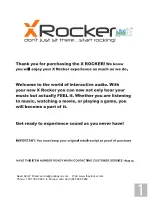
BEACH SPIKERS
BEACH SPIKERS
8
HOW TO PLAY
9
HOW TO PLAY
Control Stick
A Button
B Button
A B Button
Select the course to attack
Spike
Feint shot
Spike at blocker’s hands
ATTACKING
A Button
B Button
A B Button
Normal toss
Quick toss
Two-Return
TOSSING
As with receiving, go under the marker and press
any receiving button.
You can also toss the ball to the opponent’s side
of the court (Two-Return — pressing both A and B
Buttons) to catch them off guard.
This is usually the second of three contacts, setting up for an attack.
This is usually the last of the three contacts, sending the ball to the
opponent’s side of the court.
When attacking, watch the power gauge to the
left side of the screen. Press the A Button, with the
gauge as high as possible, to spike the ball with
maximum force. Press the B Button to perform a
feint shot (send the ball over the blocker’s hands
or drop it near the net). Press both the A and B
Buttons to attempt to spike the ball at the blocker’s
hands for a one-touch out of bounds.
POWER GAUGE: SETTING UP FOR ATTACK
On the power gauge, there will also be an
indicator for potential maximum power for an
upcoming attack. The power gauge will appear
when you set up for an attack on your second
contact (or when you call for Two Attack). The
key to the attack is a good set-up, so go under
the ball quickly and press the toss button as
early as possible for a higher potential toss.
If the power gauge does not appear, this indi-
cates that you were not in the position well
enough to set-up an attack. In this case, you
will not be able to attack on your third contact.
Press any tossing button to send the ball to the
opponent’s side.
A Button
Block
BLOCKING
Block and deflect your opponent’s attack.
When your opponent is about to attack, move in
front of the attacking player, and press the A
Button to attempt a block.
The block counts as a contact. If you attempt a
block and the ball stays on your team’s side of
the court (rather than bouncing back to the
opponent’s side), your team has only two contacts
left to send the ball back. However, the player
who attempted the block can immediately chase
and receive the ball and it will still count as the
first contact. This is the only time a “double-hit”
is allowed.
ATTACKING & BLOCKING: KNOW YOUR POSITION
When a player on the court (you or your oppo-
nent) attacks, there will be markers on the
ground, in front of the feet of both attacker
and potential blocker, indicating the left-right
position of the two.
When you’re blocking, try to exactly match
your position with that of the attacker.
If you’re attacking, watch the blocker’s position
and make the quick decision on whether to hit
the ball towards the open course, hit it over the
blocker’s hands or to spike it off of the block-
er’s hands out-of-bounds.
A Button
B Button
A B Button
Normal receive
Low receive
Call for Two Attack
RECEIVING
When the ball is in the air, there will be a marker
on the ground indicating the location where the
ball will drop. You can press any receiving button
around the marker, but try to receive in the center.
When you receive the ball by pressing both A
and B Buttons, the next player will perform an
attack (Two-Attack).
Receiving is usually the first of three contacts allowed in the game.
BeachSpikersGCmanualV03.qxp 6/13/02 11:49 AM Page 8





































